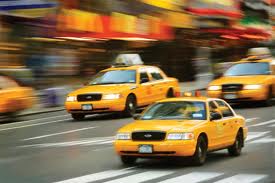On my way from Hyderabad airport to the main city the cabbie gave a lot of on the ground insights on the cab service industry, so just jotting them down to create a primer on the cab service industry India. 🙂
The total number of taxis in India could be anywhere between 500,000 to 1 million and in Hyderabad about 15,000 to 20,000. In Hyderabad, the cab industry is highly fragmented with close to 25-30 cab companies and of these almost 15 are large. The company that owns dot cabs is the largest player with a fleet size close to 2000 cabs. But what is surprising is that most of these cab companies have multiple brands in the same pricing and segment, for instance the company that owns dot cabs own sky cabs as well.
There are at least 4 different revenue models in the taxi service companies. First, the revenue model of green cabs, where the company owns the fleet, the driver gives a one-time deposit to the company and then pays a fixed amount to the company every month as a rent for using the car, the fuel cost and revenue from payments is with the driver. The cab company gives about 5 leads every day, sometimes one lead for the whole day.
Second, a slight variation to the first model. In this model the monthly payment to the company is more like an EMI than a rent for the car. So at the end of 4-5 years the driver owns the car and would have to pay only a commission to the company for the leads given by the company.
Third, the meru radio cabs revenue model, where the cab company again owns the fleet, but hires the drivers. The drivers are paid a monthly fixed salary. And the fuel and maintenance is obviously with the cab company. However, even meru is going hybrid now, with the launch of its aggregator model meru plus and its low cost taxi pilot – genie.
Fourth, is the aggregator model, multiple players come to my mind– ola cabs, uber, meru plus, taxiforsure, bookmycab. A very asset light model, in which these taxi service companies do not own a single car. These cab aggregator companies give leads to private cab owners or small cab operators and take a cut on the taxi fare (typically about 10-20%). Most of these online aggregators fit a GPS system in the car that enables tracking of the cab location at any point in time. Data analytics will play a big role in the near future, it could be used for developing loyalty programs, variable pricing, guaranteed pick up and drop time, etc based on usage patterns.
Clearly the newer players in this space are mostly going the asset light aggregator model. However, it would be interesting to see how the aggregators maintain quality of service, build the supply side inventory as they scale up and leverage data and technology to improve the service. 🙂






Vivek Aggarwal
One pertinent question – why doesn’t Ola or Taxiforsure have service in Hyderabad? Any regulations restricting them? Any clues?
Abey John
Nice summary Sweta, thanks.
Sweta P Reddy
The Hyderabad market is already too crowded with 25-30 players. I think Ola cabs and taxiforsure might be first look at low hanging fruits, cities with lesser players.